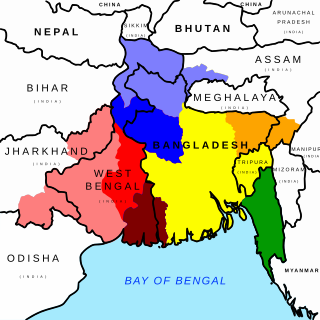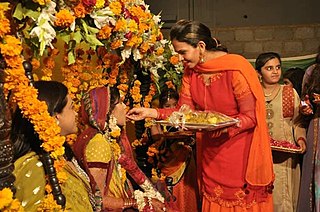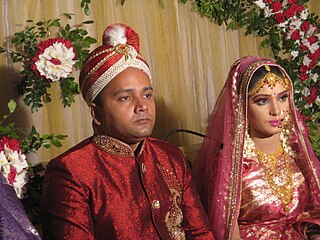
A bride is a woman who is about to be married or who is a newlywed.

Baraat or Varayatra is a groom's wedding procession in the Indian subcontinent. In North India, it is customary for the bridegroom to travel to the wedding venue on a mare, accompanied by his family members.

A sehra, sehro, mundavalya, morrah, or basikam is a forehead garland/nuptial crown worn by the bridegroom during weddings in Indian subcontinent. This decorative groom’s veil can be made either out of flowers or beads and is tied to the groom’s turban or Pagdi.
A Hindu wedding, also known as Vivaha, Marathi: Lagna (लग्न), Bhojpuri: Biyah (बियाह), Bengali: Bibaho (বিবাহ), Kalyanam, Kannada script: ಮದುವೆ (Maduve), Tamil: திருமணம் (Tirumanam), or Pelli, is the traditional wedding ceremony for Hindus. The wedding ceremonies are very colourful, and celebrations may extend for several days and usually a large number of people attend the wedding functions. The bride's and groom's home—entrance, doors, wall, floor, roof—are sometimes decorated with colors, flowers, and other decorations.

Gaye holud or Gatro Horidra (গাত্র-হরিদ্রা) is a wedding ceremony observed by Bengalis.
Nador (ನಾಡೋರ) or Nadavaru or Nadavar (ನಾಡವರ) is the name of a caste from Karnataka, India. Members of the castle are found primarily in the coastal areas of Uttara Kannada district, formerly known as North Canara, with many members also spread throughout the world. Caste members traditionally speak the Nadavar dialect of Kannada called Nadavar Kannada. They are a prominent agriculture community of the Uttara Kannada district of Karnataka, India.

Mala badal is part of the traditional Bengali Hindu wedding ceremony that involves the exchange of flower garlands between the bride and bridegroom, and is supposed to mark the first time when the bride and the bridegroom set eyes on each other. It is a ritual that is carried forward from the past, as the practice of not seeing each other before is hardly practised these days. Nevertheless, the mala badal marks the first time during the wedding that the bride and the groom are allowed to see each other.

A Bengali Muslim wedding is a Bengali wedding in accordance with the Muslim faith. It includes rituals and ceremonies that may span up to three days. In most cases, it starts with the Dekha Dekhi, followed by the nikah, which is conducted by a Qazi with a fixed denmohor. It ends with the Bou Bhat ceremony, which is popular as the wedding reception arranged by the groom's family. This is the dominant tradition of weddings seen among the Bengali Muslims of Bangladesh and the West Bengal state of India.

Marriage in Pakistan pertains to wedding traditions established and adhered by Pakistani men and women. Despite their local and regional variations, marriages in Pakistan generally follow Islamic marital jurisprudence. Marriages are not only seen as a union between a husband and a wife, but also an alliance between their respective families. These traditions extend to other countries around in the world where Overseas Pakistani communities exist.

Punjabi wedding traditions are a strong reflection of Punjabi culture with ritual, song, dance, food, and dress that have evolved over centuries.

Chura, chuda, or chudlo is a set of bangles traditionally worn by a bride on her wedding day and for a period after, especially in Indian weddings.
Ukrainian wedding is the traditional marriage ceremony in Ukrainian culture, both in Ukraine and in the Ukrainian diaspora. The traditional Ukrainian wedding featured a rich assortment of folk music and singing, dancing, and visual art, with rituals dating back to the pre-Christian era. Over time, the ancient pagan traditions and symbols were integrated into Christian ones.

Indian wedding clothes refer to the traditional attire worn by a wedding couple and wedding guests.

Muslim marriage and Islamic wedding customs are traditions and practices that relate to wedding ceremonies and marriage rituals prevailing within the Muslim world. Although Islamic marriage customs and relations vary depending on country of origin and government regulations, both Muslim men and women from around the world are guided by Islamic laws and practices specified in the Quran. Islamic marital jurisprudence allows Muslim men to be married to multiple women.
The Telugu Hindu wedding ceremony is the traditional wedding ceremony of the Telugu people in India. In the 19th century, the ceremony could last up to sixteen days. In modern times, it can last two or more days, depending on the family's financial and social status. The pelli or wedding is considered the strongest of social bonds, and is said to spiritually merge two souls opening the doors to gruhastaashramam. There is a Telugu saying that "Marriage is supposed to be a family union and not an individual formality." However, with changing mindset of the younger generation and due to globalization, marriage these days is being mainly focused solely on the union of the young couple only.
Bahaghara is the Hindu wedding ceremony performed by Odia people in the Indian state of Odisha. It is the main ritual of an Odia Hindu wedding.

Traditional Hajong marriage is a ceremonial ritual that involves a marriage established by pre-arrangement between families. Within Hajong culture, romantic love and widow re-marriage were allowed, and monogamy was the norm for the Hajong people.
The Four Ceremonial Occasions. The four rites of passage celebrated in this tradition are the coming of age, marriage, death, or the funeral rites, and rites venerating the ancestors. The word Gwanhonsangje an acronym, made of the first letter of each word.

The wedding of Prince Edward, Duke of Kent, and Katharine Worsley took place on Thursday, 8 June 1961, at York Minster in York, England. Prince Edward, Duke of Kent, was the eldest son of Prince George, Duke of Kent, and Princess Marina of Greece and Denmark, while Katharine Worsley was the only daughter and fourth child of landowner Sir William Worsley, 4th Baronet.
Sindhi traditions and rituals refers to some Sindhic practices that span a person's life. They differ across regions.













